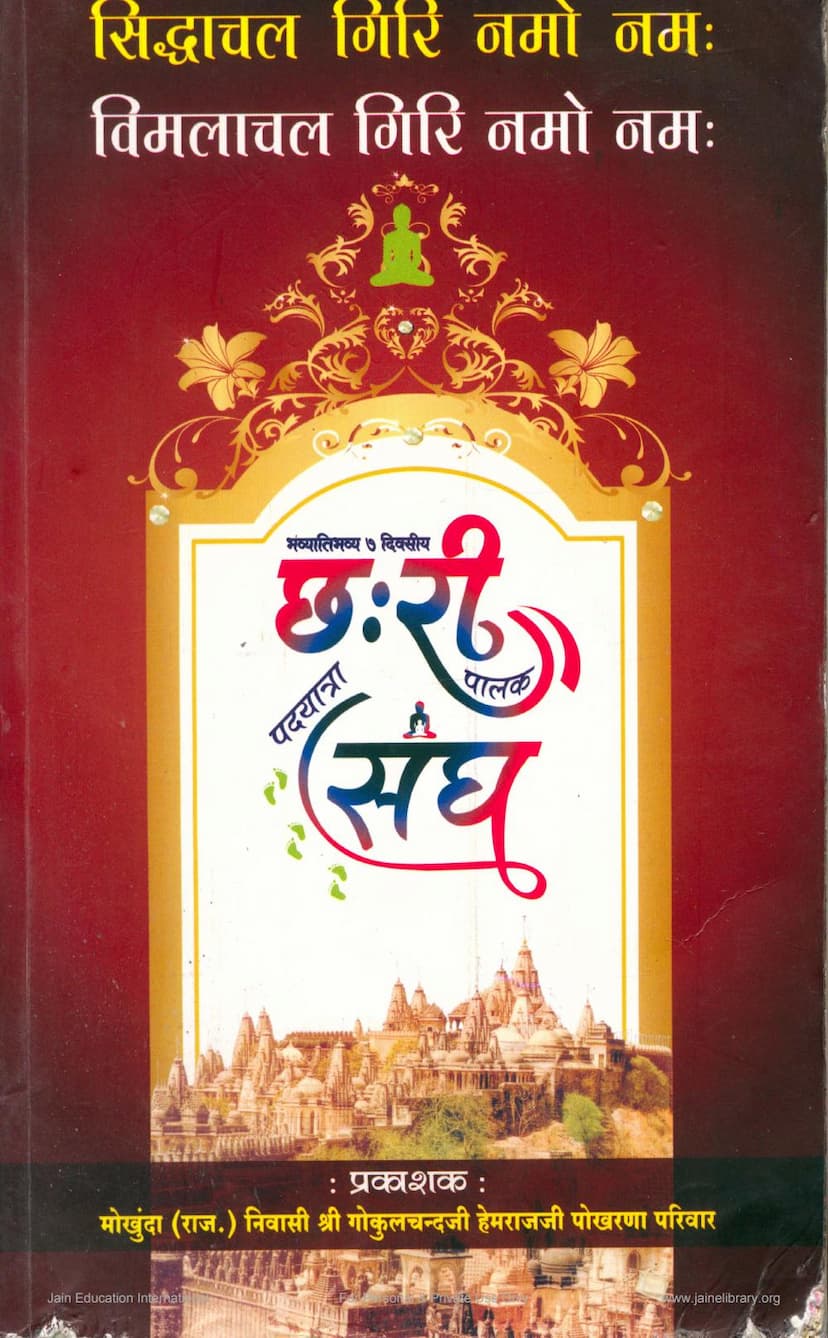Chari Palak Padyatra Sangh
Added to library: September 1, 2025
Loading image...

Summary
This Jain text, titled "Chari Palak Padyatra Sangh," published by the Rajhans Group of Industries, is a detailed guide and devotional offering related to a 7-day pilgrimage (Padyatra Sangh) to the holy sites of Siddhachal (Shatrunjaya) and Vimalachal. The pilgrimage, which commenced on December 20, 2013, is presented as a spiritual journey of profound significance.
Key Aspects and Content:
- Homage and Reverence: The text begins with salutations to Siddhachal and Vimalachal Giris, and pays deep respect to the esteemed Acharyas of the Tapa Gachha lineage, including Shri Prem-Bhuvannbhanu, Jayghosh, Jitendra, and Gunratnasuri.
- Inspiration and Direction: The booklet is dedicated to the auspicious inspiration of Acharya Shri Vijay Gunratnasuri Maharaaj and compiled/edited by Acharya Shri Vijay Rashmiratnasuri Maharaaj. The Pokherna family from Mokhunda, Rajasthan, are the publishers and recipients.
- Shatrunjaya Tirtha Mahatmya: A significant portion of the text is dedicated to explaining the profound spiritual importance of Shatrunjaya (Siddhachal). It emphasizes that those who worship this sacred hill often attain liberation in their third life, or even instantaneously with elevated devotion. The text highlights Shatrunjaya as a bridge between the material world and the city of liberation (Shivnagri).
- Historical and Spiritual Significance of Key Locations:
- Shatrunjaya (Siddhachal): Referred to as the "Mahatirtha" and "Siddhagiriraj," it is considered the most sacred and revered of Jain pilgrimage sites. The text lists numerous souls who have attained moksha (liberation) from this holy mountain, including various Munis, Ganadhars, and even divine figures. It states that the future Tirthankaras will also preach and attain moksha here.
- Taladhwajgiri (Talaja): Described as an ancient peak of Shatrunjaya, it is known for its beautiful temples and the presence of Lord Sumatinath.
- Kadambgiri (Karali): This site is significant as the place where Sampati, a Ganadhar of the 24th Tirthankara, attained liberation along with millions of monks. Lord Rishabdev is the main deity here.
- The Concept of Bhav Yatra (Mental Pilgrimage): The text strongly advocates for a "Bhav Yatra" (pilgrimage of devotion and contemplation) rather than just a physical journey. It guides the reader to close their eyes and visualize the spiritual journey, focusing on the devotion and presence of the Tirthankaras and Siddhas.
- Detailed Journey Descriptions: The book provides a step-by-step, almost minute-by-minute, guide for undertaking the Bhav Yatra up Shatrunjaya. It describes:
- Approaching the mountain: Visualizing the journey, passing by other holy sites.
- The ascent: Mentioning specific gates, steps, and landmarks like Jay Taleti, the elephant statues, the sacred stone, various temples, and the dwellings of holy souls.
- Key Sites and Deities: The text systematically guides the reader to various temples and places of reverence, including those dedicated to Lord Rishabdev, Lord Ajitnath, Lord Dharmanath, Lord Shantinath, Lord Neminath, Lord Parshvanath, and others. It highlights the significance of foot-imprints (charan-padukas) of Tirthankaras and Ganadhars.
- Specific Deities and Legends: The text narrates the stories associated with certain places, such as the legend of Hinglaj Mata, the significance of Gautam Swami's foot-imprints, the historical accounts of emperors like Kumarpal and kings like Bharat, and the stories of devotees like Javadsaha, Vastupal-Tejpals, and Samraosh.
- Rituals and Practices: The guide encourages chanting specific mantras ("Namo Jinanam," "Namo Siddhānam"), performing "Chaitya Vandanas" (acts of worship at temples), and maintaining mindful contemplation throughout the journey.
- The Importance of Purity: The text cautions against certain actions that can cause "Ashatana" (disrespect or offense) to the holy site, such as consuming curd at certain locations.
- The "17 Uddhars" (Renovations): A significant section details the 17 major renovations and restorations of the Shatrunjaya hill throughout different epochs, highlighting the contributions of various kings, emperors, and devotees. This section provides historical and mythological accounts of each renovation, emphasizing the continuous efforts to preserve the sanctity of the pilgrimage site.
- Devotional Songs and Stanzas: The book is interspersed with numerous devotional songs, prayers, and verses (stutis) in Gujarati and other languages. These are intended to guide the pilgrim's emotions and enhance their spiritual experience. They offer praises to the Tirthankaras, express devotion, and convey the sanctity of the pilgrimage.
- Visual Aids: The book includes a map of the Shatrunjaya Bhav Yatra, illustrating the path and significant locations.
- Philosophical and Ethical Teachings: Underlying the pilgrimage narrative are core Jain principles of non-violence, detachment, devotion, and the pursuit of liberation. The emphasis on "Bhav Yatra" underscores the importance of inner purification and spiritual focus.
In essence, "Chari Palak Padyatra Sangh" serves as a comprehensive spiritual guide, historical record, and devotional compendium for undertaking a profound pilgrimage to Shatrunjaya and Vimalachal, aiming to deepen the faith and spiritual connection of the Jain community with these sacred Tirthas.